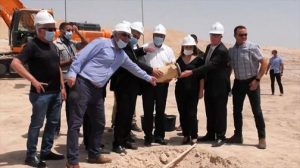The estuary of Jerusalem and the PA, which for years flowed to the stream, caused a severe environmental hazard in the Judean Desert. Yesterday the cornerstone was laid for the
restoration project – and the purified water will be used to irrigate Israeli and Palestinian date plantations. 1.3 km long tunnel will prevent damage to nature. Jerusalem Mayor: “Green
enterprise of national size”.
Cornerstone for Kidron Joint Israel-Palestinian Wastewater Treatment Facility For years, the sewage from Jerusalem and the Palestinian Authority has flowed to Nahal Kidron, causing severe environmental damage in the Judean Desert. The wastewater seeped into the groundwater and the banks of the stream were filled with construction waste and garbage.
Yesterday, the cornerstone was set for the Kidron River rehabilitation project and the wastewater transfer to a treatment plant – with the purified water used to irrigate Israeli and Palestinian date plantations. It is a program of more than NIS 800 million, which includes rehabilitation and replacement of damaged sewage infrastructure, laying of infrastructure for new wastewater disposal, building waste and refuse removal, wastewater absorption in the “Og” treatment plant and making it usable for agriculture.
The Kidron River route starts from Mount Scopus in Jerusalem and descends into the Judean Desert through the Hurkanya Valley to the Dead Sea area. The wastewater comes from downtown neighborhoods, including Safra Square, where the capital city and eastern neighborhoods are located. As part of the project, the sewage will be stopped and a collection line will be drained to drain the sewage for several kilometers. The Palestinian Authority will also drain its sewage through an eight-kilometer pipe. These wastewater flows will also reach the Joint Wastewater Treatment Facility in Og River Valley.
One of the complex parts of the plan is the construction of a tunnel that will lead the wastewater into the area of the Kidron desert, in order to avoid damaging nature and the ancient monastery of Mar Saba. It should be noted that the area in this section is not very accessible and the stream channel passes over archaeological sites and heritage sites. To avoid damaging them, a route will be diverted from the sewage collection from the river channel and an infrastructure tunnel will be developed at a depth of about 60 meters, about six meters wide over 1.3 kilometers. Inside the tunnel, wastewater collection systems will be located along the Judean Desert and will be temporarily absorbed in the wastewater treatment plant in the Hurkania Valley where sedimentation and treatment ponds were used.
Jerusalem Mayor Moshe Leon said: “For the first time, we are implementing a green project of national size. The project reflects our commitment to the environment and its conservation as
green and clean. This is just one aspect of Jerusalem’s revolution in environmental matters, improving its face and making it a greener city.” Minister of Water Resources MK Ze’ev Elkin added: “About half of Jerusalem’s sewage is polluting the Kidron River – which is one of the most serious environmental hazards untreated so far. A lot of hard work was done here, which included a lot of coordination with government, military, municipal and the Palestinian Authority. ” Elkin went on to say that “despite the many difficulties, we did not give up and our vision becomes a reality. Not only will Jerusalem’s sewage no longer pollute the environment, but it will serve as irrigation water for Jordan Valley farmers and Palestinian farmers.”
Avi Blashnikov, chairman of the Gihon Municipal Water Utility and the sewage treatment plants in Jerusalem, concluded: “We are embarking on one of the important projects for the State of
Israel, the city of Jerusalem and the residents of the surrounding area. This is a project that will fully address the wastewater problem of the eastern city and all the communities along the Kidron and restore the river’s majesty, environmental, heritage, tourism and historical splendor. ”
Wastewater Treatment Project Cost: 800 million
_____________________________________________________________
For further information:
see Hebrew article and 2020 Hebrew news watch videos here
2015 news video from The Forward here
Dead Sea Drainage Authority here
Hospitality in the Kidron/Wadi El-Nar River Basin-Green Pilgrimage Mountain Bike here
Further background reading:
Glenn Yago, “The Path to Peace Runs through Sewage,” Haaretz, July 28, 2013
Israel State Comptroller Report on Water Pollution between Israel and the West Bank, Executive
Summary May 2017
(English summary of 1,481 page report in Hebrew available here).
Financing Kidron/Wadi El Nar Revitalization: A Bridge to Development, Milken Innovation
Center, 2013
Financial Innovations for Freshwater Revitalization: Transboundary Project Finance in Israel,
Jordan and the Palestinian Authority, Milken Institute Financial Innovation Lab, November
2009.
T.E. Levy, et. al., At Risk World Heritage and Virtual Reality Visualization for Cyber-
Archaeology: The Mar Saba Case Study, in M. Forte and Helena Murtiera (eds.) Digital Cities:
Between History and Archaeology, Oxford: Oxford University Press, 2020.

